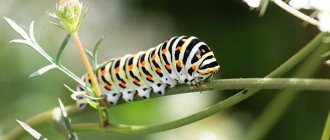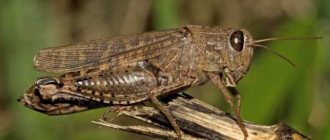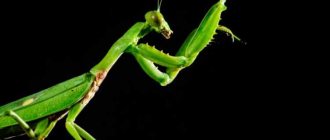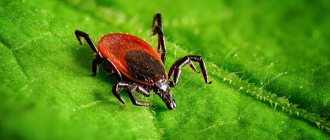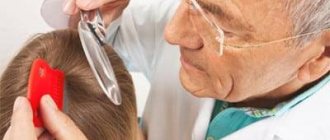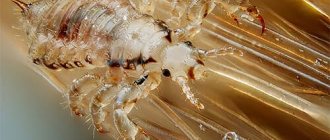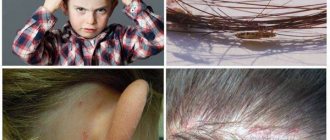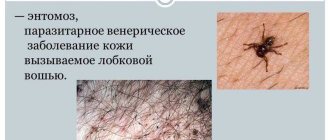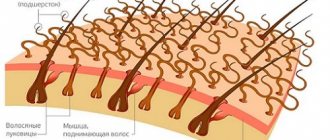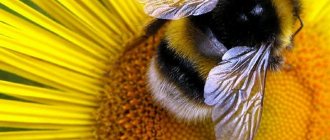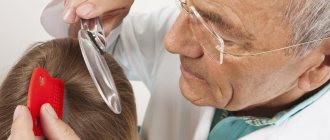Lice drink blood, so it makes no difference to them what kind of hair they get, dyed hair or natural hair. They need hair only to hide in it and secure their larvae. Many girls think that parasites cannot live on dyed curls, but the composition of modern dye does not harm the skin, hair and parasites. In this article, you will find out whether lice can grow on dyed hair and whether they can be removed by re-dyeing.
Habitats of lice in nature - where the parasite usually lives in its natural environment
Let's figure out where parasites live; their habitats differ depending on the type of insect.
There are three types of lice:
- Head - lives in the hair of the human head.
- Pubic - settles on hard hairs: eyelashes, eyebrows, pubic area, armpit.
- Clothes - lives and reproduces on clothes, moves onto a person only to bite him.
Lice that parasitize a person cannot remain outside his body for a long time. The fact is that they feed only on blood; their oral apparatus is not adapted to any other type of food. And without food and warmth, parasites can exist for only a short time.
Of course, any louse can end up on bedding or a piece of furniture, but it definitely wants to move to a “warm place.”
Do lice live on colored hair and can they get there?
Hair dyeing is not a panacea for lice; they also land on the head. The risk of lice infection decreases only in the first 2–3 days after dyeing: the pungent odor left from treating hair with chemicals can “scare off” parasites for some time, but as it weathers, the likelihood of lice infection increases significantly. And the structure of the hair changes during the first days after coloring: nits do not attach to them, but simply fall off.
The parasites feed on blood, and the hairs are used by mature females to attach nits: they secrete a special secretion that can attach the larva to the hair. Thus, lice can appear on dyed hair, live and reproduce in the same way as on natural hair, and the dye in no way interferes with the breeding of new offspring.
results
Can lice appear after dyeing? Definitely yes. After the first session, all parasites cannot completely disappear; with a hundred percent probability, larvae will remain on the curls, even after thorough combing, which will soon turn into adults.
According to experts, the use of ammonia dyes helps get rid of lice by only 75%, no more. To completely eliminate the problem, you will have to repeat the procedure 2-3 times. It is advisable to do this after 10 days, so that the nits have time to turn into sexually mature individuals. Frequent application of chemical compounds will certainly damage the strands, and you will have to restore them for a long time.
Is it possible to cure head lice with dyeing?
There is no clear answer to this question. The fact is that the active components of hair dye - ammonia and hydrogen peroxide - have a negative effect on living parasites, killing them, but even the most aggressive components are powerless against nits : their protective shell is too strong and cannot be corroded by a permanent composition.
The only thing that dye can do is destroy the sticky secretion, thanks to which the eggs are attached to the hair, as a result of which the nits simply begin to fall off the hairs. But even outside the hair, the larvae continue to wait “for their time,” because after the start of the life of a new individual, the risk that one of the household members will become a new “object of food” increases significantly.
Lice eggs must be removed only mechanically , by frequently combing the hair with a thick comb or manually, literally examining and sorting out each hair.
The effectiveness of treating head lice using hair coloring products is no more than 75%, and then only if the disease is not advanced.
The remaining 25% is a kind of risk zone that arises in the absence of measures to remove nits from hair: even if at least one living egg remains in the head, after a while a living individual will hatch from it and they will start again.
Symptoms of neurocysticercosis
Symptoms of parasites in the brain appear gradually. With a small size of the parasite, the manifestation of the disease is characterized by internal irritations, the patient’s sensitivity decreases and speech is impaired.
With the development of cerebral cysticercosis, attacks of epilepsy appear, which pass with convulsions. The patient suffers from mental disorders, hallucinations, and depression. With the onset of edema, the patient experiences dizziness, nausea and vomiting.
Symptoms of the presence of parasites in the human brain depend on the location of the source of the disease. If neurocysticercosis is located in the cerebral ventricles, the patient develops Bruns syndrome, in which the lumens of the 4th ventricle may be blocked by parasitic formations. With such localization in a patient:
- Changed head position
- Severe headaches
- Respiratory dysfunction
- Nausea and vomiting
- Increased sweating
- Consciousness is confused
- The functioning of the heart is impaired.
When the foramen of Monroe closes, the symptoms are similar to those of a tumor and are accompanied by disturbances of consciousness. As a result of infection of the base of the brain, basalt-type meningitis develops. With such an infection, the following manifestations are possible:
- Vomit
- Headache
- Optic nerve damage
- Bradycardia
- Changes in blood composition.
If a diagnosis is made in a timely manner and effective measures are taken, the probability of a favorable treatment outcome is 50%.
Which paint is suitable for treatment, TOP 3 brands with prices
The main criterion that a paint intended to combat head lice must meet is that it must contain ammonia and hydrogen peroxide (hydroxide) . It is these components that destroy the chitin of parasites, paralyze their respiratory system, as a result of which the insects die from asphyxia.
A larger percentage of the content of these components is contained in cosmetics for lightening and blonding, that is, when choosing a color, preference should be given to light tones of the coloring agent. As for the brand, the brands listed below have been especially popular lately; In addition, each of them contains not only ammonia, but also other components designed to protect the hair structure as much as possible.
- Estelle De Luxe . Contains guarana extract, green tea and keratin complex, which maintain water balance, making hair soft and silky. Approximate price – 275 – 340 rubles per 60 ml.
- Pallet . The composition includes vegetable oils and a keratin complex, which slightly compensate for the damage caused to the hair as a result of exposure to strong chemicals. The estimated price is from 100 to 300 rubles, depending on the region or store.
- Garnier . Ammonia dye, in addition to ammonia, contains vegetable oils and lanolin, which gives hair shine and smoothness. Approximate price – 90 – 150 rubles.
Gentle ammonia-free paint in the fight against lice is absolutely useless: it can only change the color of the insect and make it less mobile.
Which paint to choose?
So, a lice infestation has occurred, and to solve this problem, the hair dyeing method was chosen. It should be remembered that dye containing ammonia is best suited for these purposes; it has a pungent odor that can stay on the hair for several days. Ammonia destroys the chitinous shell of the insect, which can cause the death of the parasite, but the paint will not affect the nits and after a certain time new lice will appear from them. As a rule, hair dyes containing ammonia are much cheaper than gentle ones; you can purchase them at any household cosmetics store.
Hair dye containing hydrogen peroxide also has an adverse effect on the health of lice, in addition, it can destroy the sticky secretion that holds nits on the hair. Immediately after painting, it would be a good idea to comb the strands to remove dead insects and loose eggs. After a few days, the head should be re-treated with a special solution to completely destroy the surviving insects.
Instructions for using paint against lice, how many times should you apply paint?
- Conduct an allergy test: apply a small amount of paint to the skin behind the ear and wait for 12 hours. If there are no undesirable reactions to the epithelium (redness, peeling, itching, rashes), then you can safely proceed to staining.
- You should put a protective plastic cape over your shoulders and gloves on your hands.
- Unwashed hair must be combed thoroughly, then using a brush, apply the prepared dye evenly to the hair.
- You need to put a plastic cap on your dyed hair, then a towel to create conditions close to a greenhouse.
- Leave the coloring composition on your head for the time specified in the instructions.
- Hair must be thoroughly rinsed with plenty of running water, then washed with shampoo.
- The final stage is applying the balm.
Definitely, lice will not die from staining alone. Hair treatment should be done several times: usually 2 - 3 procedures are required with an interval of 3 - 5 days. However, such intensity of coloring can cause significant harm to the hair and scalp.
Before purchasing paint for coloring, you need to pay attention to the expiration date: if it is approaching the end, then you should not buy the product, it may not be suitable for treating head lice.
Transmission routes
Parasites can also be transmitted through personal hygiene items, combs, hairpins, hair ties and hats.
It is possible, but less common, to become infected with head lice through bedding and pillows. More often, infection occurs when sleeping together. It is very rare, but it is not impossible to become infected with lice while swimming in stagnant water if people with lice are swimming nearby.
Most often, infection with pediculosis occurs in the summer, in places with large crowds of people - in children's camps, kindergartens, etc.
No one is immune from head lice infection. Of course, systematic hygiene procedures are the main methods of prevention, but they do not exclude the possibility of infection.
And the process of reproduction of lice from the moment they land on the head is carried out continuously, individuals increase exponentially. If you do not take any measures to eliminate parasites, they will live on the scalp indefinitely.
Now you know how long a lice lives on the head, whether lice live outside the head and whether they can live on animals.
Parasites can appear even in clean people who live in good conditions. They are caused by close contact with an infected person. Parasites pass from the “host” during games, sexual intercourse, wrestling, and accidental touching of the head.
Where do head lice in children come from? In children's groups, the spread of these insects occurs at lightning speed. They can be transmitted to healthy babies through shared towels or pillows, when bathing in the bathtub or wearing other people's hats. Therefore, a high risk of infection is observed in gardens and schools, swimming pools, hotels, and trains.
Contraindications
Not everyone can perform “dye therapy”. Those who have:
- There are wounds, pustules, and rashes on the surface of the skin under the hair.
- The bite site transformed into a sore.
- Pediculosis in advanced form (a huge number of nits and lice are observed on the hair).
- Hair is too weak or has been exposed to other chemicals.
- Pregnant women and children should look for other, less harmful ways to kill parasites.
During or after the coloring procedure, it is possible to develop undesirable side effects, among which the most common are allergic reactions (itching, burning of the skin surface), deterioration of the hair structure (thinning, brittleness, delamination) or hair loss, problems with the scalp (dryness, dandruff). , peeling of the epithelium).
Alternative methods of getting rid of parasites
Let's consider the most popular alternative remedies against head lice:
- Henna . The remedy along with basma will not get rid of pediculosis, but there is still some wisdom in using these drugs. They contain a substance that can destroy the adhesive secretion, as a result, the louse cannot attach the nit to the hair, and, sooner or later, the brood of parasites will disappear. In addition, henna is used to alleviate the condition of a person who has been attacked by body lice: the healing composition will relieve itching from bites and inflammation.
- Hair fixation spray . Some brands of hairspray, for example, "Prelest", contain dimethicone, a derivative of silicone, which is part of many anti-lice medications. As a result of its exposure, lice die from asphyxia almost instantly, and nits cannot hatch because the silicone blocks the entrance hole. The etching technology is simple: in a well-ventilated room or outdoors, protecting your face with a cape or polyethylene, you need to apply styling product along the entire length, paying special attention to the root zone. The next step is to wrap your hair in plastic and a towel for 8 hours. After time, the head should be thoroughly washed with shampoo, and the nits should be combed out. For one treatment, you may need from 1 to 2 cans depending on the length of the hair.
- Vinegar . The evaporation of vinegar makes the lice inactive and weak, which makes it easy to remove them from the hair. Vinegar also dissolves the adhesive, thanks to which the larvae are attached to the hair, so they can also be easily removed. If you put a plastic cap on your head moistened with a solution of vinegar (1 tbsp. 9% per 100 ml of water for children over 3 years old and 1 part vinegar to 2 parts water for adults), the nits will become dry, which means that young individuals do not appear.
- Kerosene . The chemical composition of the substance kills adults outright, repels other potential “settlers” with the smell, and peels off the larvae from the hair, which greatly facilitates the process of combing out nits. Since ancient times, the following remedy has been prepared to kill lice: 1 tbsp. kerosene mixed with 2 tbsp. vegetable oil and 30 ml of any shampoo. The mixture is applied to moistened hair, the head is covered with polyethylene and a towel for 40 minutes, after which the hair must be washed first with a solution of vinegar (1 tablespoon per 1 liter of water), then with running water.
- Hydrogen peroxide will do an excellent job of killing lice, but will leave the larvae alive: their thick shell is not corroded by the drug. However, like previous products, peroxide destroys the adhesive secretion, as a result of which nits can be easily removed from the hair. Since hydrogen peroxide is a rather aggressive substance, it should only be used in the form of an aqueous solution (1 part peroxide to 2 parts water). The duration of the procedure is 7 – 9 minutes.
In addition to these substances, traditional medicine recommends resorting to dust soap, beet juice, fresh cranberries, vodka or alcohol in the fight against pediculosis.
ESTEL Love Permanent cream hair dye, 115 ml
The product acts as gently as possible compared to analogues. The composition includes ylang-ylang oil and beeswax, which ensures hair protection.
ESTEL Love boasts a huge palette of colors
From blonde to black. Compound. How to kill parasites at home
In the package you can find:
- cream paint;
- developer in the form of an emulsion;
- conditioner balm.
Contains ammonium hydroxide. This substance has a negative effect on lice, but its level of effectiveness is slightly lower compared to concentrated peroxide.
Instructions for use:
- Mix the contents of the package with paint and developer.
- The substance is applied to the hair.
- The duration of the procedure is 20-40 minutes.
- The product is washed off.
- Apply balm.
Paint cost
In order not to waste time searching for the right type of product, you can look at some offers in the table below.
| Name of shop | Cost, rub. |
| Ozon | 150 |
| Joy by Joy | 91 |
| My-shop | 120 |
| Commega | 111 |
| Platypus | 111 |
Basic ways to combat and prevent pediculosis
It is more logical to prevent any disease than to try to get rid of it for a long time . Therefore, following a number of simple recommendations, although not 100%, will still protect your family:
- Use a personal comb and towel.
- Do not put other people's headgear on your head.
- Choose a beauty salon responsibly: you need to trust those who are characterized by impeccability in everything.
- Try to avoid close head contact with unfamiliar people.
- Regularly (once a week) examine the head to detect lice.
If a case of head lice infection does occur in the family, then there is no need to panic. After treatment of the head, it is necessary to change the bed linen, wash the patient’s clothes, iron them, and steam all the things that the sick person came into contact with. Particular attention should be paid to the comb he used: it should be washed and steamed.
- about the author
- VK profile

